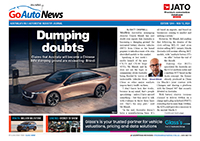Make / Model Search
News - General News - RegulationCameras are go for rear visionMirror mirror: Changes to ADR (Australian Design Rule) regulation to bring it into line with Europe means rear-view mirrors could be replaced by cameras and sensors in new cars in the not-too-distant future. ADR/EU harmonisation means rear-view mirrors can be replaced by cameras4 Dec 2014 By IAN PORTER CAR-MAKERS will be able to sell vehicles in Australia that use video cameras and on-board screens as rear-vision systems in general driving, not just for the purpose of monitoring reversing. Adoption of cameras for rear-vision systems has been attractive to car-makers for some years because of the potential for aerodynamic gains and the consequent fuel savings. The possibility of using cameras has come about through Australia’s adoption of UN Regulation 46 last week, which approved the use of some devices other than mirrors for use in rear vision. Under the harmonisation policy adopted by the Australian government, the Australian Design Rules for vehicles are automatically updated whenever a United Nations automotive regulation is changed or introduced under the umbrella of the United Nations Economic Commission for Europe. Announcing the adoption of UN Regulations 19 and 46 last week, assistant minister for infrastructure and regional development Jamie Briggs said the changes could save the local car industry $1 million in compliance costs. Confirming the change, the department of infrastructure said the revised regulation came with strong caveats. Cameras used for “indirect vision” must operate at all times during driving and they must meet the stringent performance and field of vision requirements that mirrors meet, according to information from the department’s media team. There is no restriction on where the video can be displayed. It can be in the dashboard screen, in a section of an internal rear-vision mirror or in the frame of a front door, in the line of sight used to view an external mirror. However, there is not likely to be a sudden switch to video cameras and monitors, according to SMR Automotive Australia, the Adelaide arm of Samvardhana Motherson Reflectec. “The OEMs (original equipment makers) have been talking about replacing mirrors with video for 15 years at least,” SMR Australia marketing director Sam Vial told GoAuto. “Back then, we thought it would be a threat in five to 10 years but, looking at it now, we think it is still five to 10 years away.” He said he believed one of the German manufacturers had recently obtained a waiver so that it could sell a limited edition electric vehicle with cameras and a monitor as its rear-vision system. However, he said it would not be possible to do a straight replacement, dropping mirrors and installing video cameras and monitors. “The biggest problem they still have with video is that it doesn’t give you any depth. So, if you go to a 2D screen, you lose the 3D depth that an actual mirror image provides.” Mr Vial said it was not just a matter of leaving the reversing camera on all the time. “The reversing camera is only good for reversing. It still doesn’t do anything for you in terms of looking out your rear-view mirror when you are driving forward. “Most of those cameras have fish-eye lenses as well. So you do get a very distorted image of what’s happening.” He said that’s why reversing camera images need to have the yellow and red guiding lines on the screen when a vehicle is reversing. “You need to have perception markers there to make sense of what’s going on.” Mr Vial said the technology in rear vision was developing rapidly and that SMR’s global research and development effort had been working on videos and monitors for years. “I am firmly of the belief that cameras will form a much greater part of the vision systems to a vehicle, but how that works, to be honest, the OEMs are still trying to work it out.” He said cameras and monitors would most likely be used in a hybrid system, and not necessarily with mirrors. “The OEMs are looking at hybrid systems where they’ll potentially replace mirrors with a camera system, but that will be backed up with an additional sensory mechanism, most likely radar. “They’ll have some other system they will have to incorporate with the camera. You have to create depth in order to see where things are, and just having a video isn’t good enough. “They have proven categorically now that video alone is not a solution. From a safety perspective, it would worsen safety, not improve it.” SMR Automotive Australia is part of the global Samvardhana Motherson Group (SMG). SMG exceeded revenues of $US5 billion ($A5.87 billion) in the year to March 31. Profit after tax jumped from $A84.4 million to $A145 million.” Samvardhana Motherson Reflectec group makes 30 million exterior mirrors a year in several factories around the world, including its Adelaide operation. This gives it a market share of about 25 per cent in light vehicles.  Read more24th of February 2014  AADA fears flood of used importsDon’t relax laws on used vehicle imports, says AADA30th of March 2012  Australian government gives Isofix the nod at lastFitment of international-standard Isofix child seat system finally legalised in Oz |
Click to shareGeneral News articlesResearch General News Motor industry news |











Facebook Twitter Instagram